Visually, Chinese language clearly exposes what somehow corresponds to Western’s languages Greek/Latin etymology, and which is, to most westerners, hidden by languages’ evolutions.
We propose here to clarify this point through to study of a few Chinese characters. There doesn’t seem to be a consensus regarding how to interpret characters, but regardless, such studies still have values as mnemonic.
I encourage the reader to extend such analyses as he sees fit.
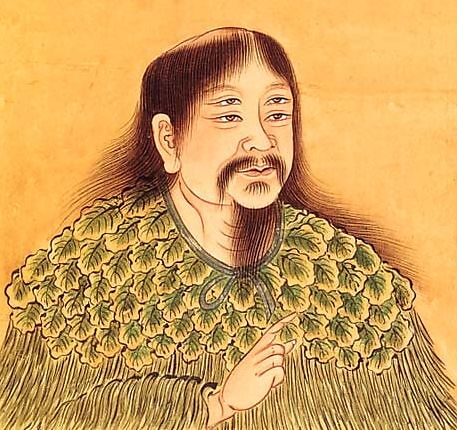
Canjie, legendary inventor of Chinese characters (c. 2750 BC) through wikimedia.org – Public domain
Introduction
Structure
For the purpose of this article, let’s satisfy ourselves with a simplistic view of the language.
Mainly, we’ll consider that Chinese “words” are actually small, stylized images, similar to Egyptian hieroglyphs, or emojis. Such images changed in 5,000 years, but the core idea remains, and many kept a similar form.
文’s ancient/archaic forms (language, culture, etc.): Oracle/Bronze/Silk/Seal/Big seal through wikimedia.org – Public domain
And, most characters are created by composing simpler characters.
To say it differently, Chinese characters are small Lego® pieces that one can agglutinate to form bigger pieces.
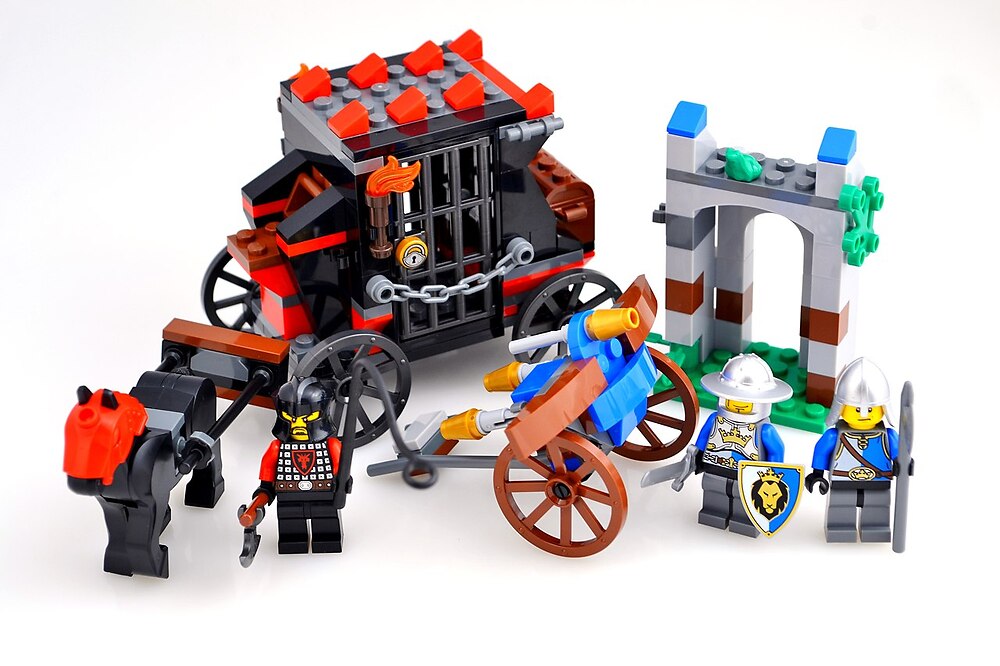
Lego Castle set 70401: Gold getaway
by
Ɱ
Chinese speakers or experts may disagree, as the reality is far more complex. However, our goal is to gently introduce the language; our approach furthermore doesn’t seem too far away from traditional/classical ones.
Broadness of interpretation
Interpreting characters presents the same subtleties as semantically interpreting paintings. Already during the Han dynasty (202 BC to 220 AD), for instance because of the diversity of Chinese scripts, different authors proposed different interpretations for the “same” character, [Bottero2002], §1.2:
Convinced that the Clerical script (li shu 隸書 of the Qin) was the script invented by Cangjie (the legendary inventor of the Chinese writing), supporters of “Modern Texts” based their analyses of the graphs on this script, while Xu Shen based his own analysis on the older small seal script (xiao zhuan 小篆), in order to retrieve the original meaning of the characters. He therefore proposed a very different analysis of the same characters zhang/chang 長, dou 斗 and hui 虫.
It’s also worth noting that [Bottero2002], §1.3 seems to present ancient characters interpretations as mostly semantical:
The interpretations of the graphs taken from the Zuozhuan, as well as from the Weishu, presented in this section, give us some idea about the context in which Xu Shen’s work was undertaken: no matter what script style (ancient or clerical) is discussed, the early graphic glosses always consist in simple semantic analysis. According to the liu shu theory, the analysed graphs either are classified as xiang xing “pictographs” or as hui yi “ideographs”, but never as xing sheng zi 形聲字 “ideophonographs.” In a more general sense, characters are seen as true symbols of reality.
Thus, proposing the “correct” interpretations of some characters, satisfying every historical and contemporary expert, seems unlikely.
However, proposing reasonable semantic interpretations of the character’s appearance seem not only to be in line with traditional Chinese scholars' mindset, but also provides a great way to help character memorization. As we proposed for paintings, we will, more or less arbitrarily, narrow our interpretation to the scope of Chinese culture.
Note: The character 文 by which we’ll start our analysis, covers both the ideas of culture and language.

Guilin Panorama, Autumn 2011
by
Chensiyuan
About zhongmu
We make use here of zhongmu, a web-based piece of software aiming at helping/automatizing Chinese characters decomposition.
Here’s an example panel; you can try clicking the blue question mark top-right to display the inline-help.
Exploration
Culture/Language: 文 [wén]
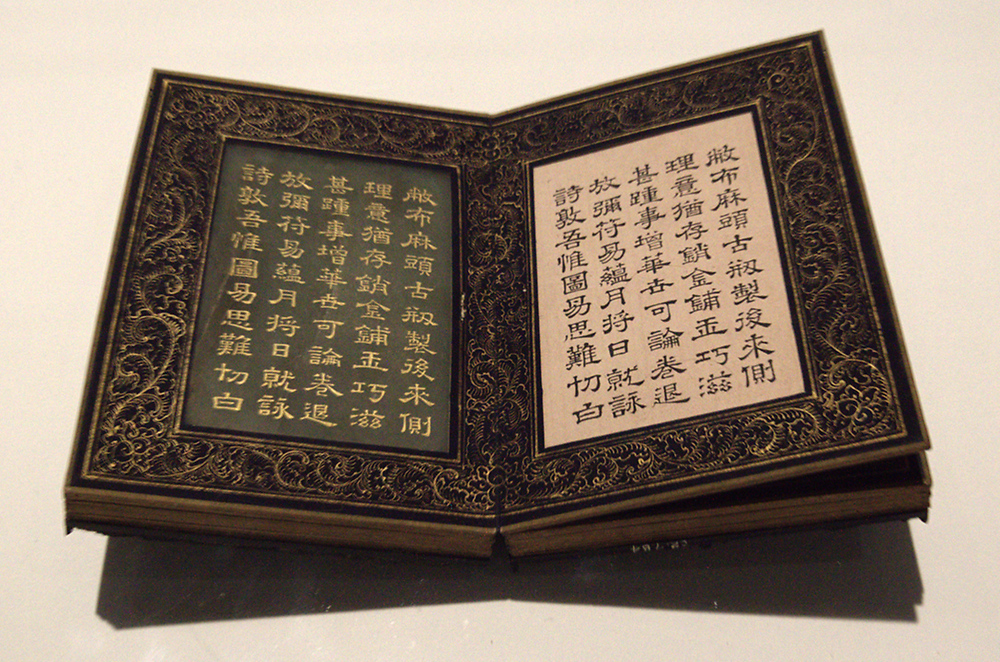
Poems of The four treasures in a schoolar’s study (Qing)
by
mpan
It follows from basic decomposition that “culture” is the assembly (亠) of various kind of (moral, political, etc.) regulations (乂).
The interlocking lines (乂) could be interpreted as a representation of written, calligraphic language, hence the “language” meaning: that which covers (亠) written form (乂).
Archaic and ancient forms of the word depict a man with a great chest, apparently considered seat of learning, sometimes filled with a heart:
文’s ancient/archaic forms (language, culture, etc.): Oracle/Bronze/Silk/Seal/Big seal through wikimedia.org – Public domain
That we can interpret as a cultivated man, hence the “culture” meaning.
See also 慧 and some teachings of the Guanzi:
The duality of the meaning (“culture”/“language”) doesn’t feel incidental, and likely is the result of some observation by ancient people.
Note: Such an interrelation between between language, culture and thinking process/worldview, has recently been explored by modern thinkers; for general introductions, see linguistic relativity (Sapir-Whorf hypothesis), Orwell’s Politics and the English language, General semantics; for a deeper, specific analysis, see [Everett2005].
Good: 好 [hăo]
An archetypal example for Chinese language, appearing for instance in Chinese “hello”: “你好” [nǐ hăo].
From experience, when presented with such a decomposition, Westerners naturally understand 好 as a woman’s (女) love and care for her child (子).
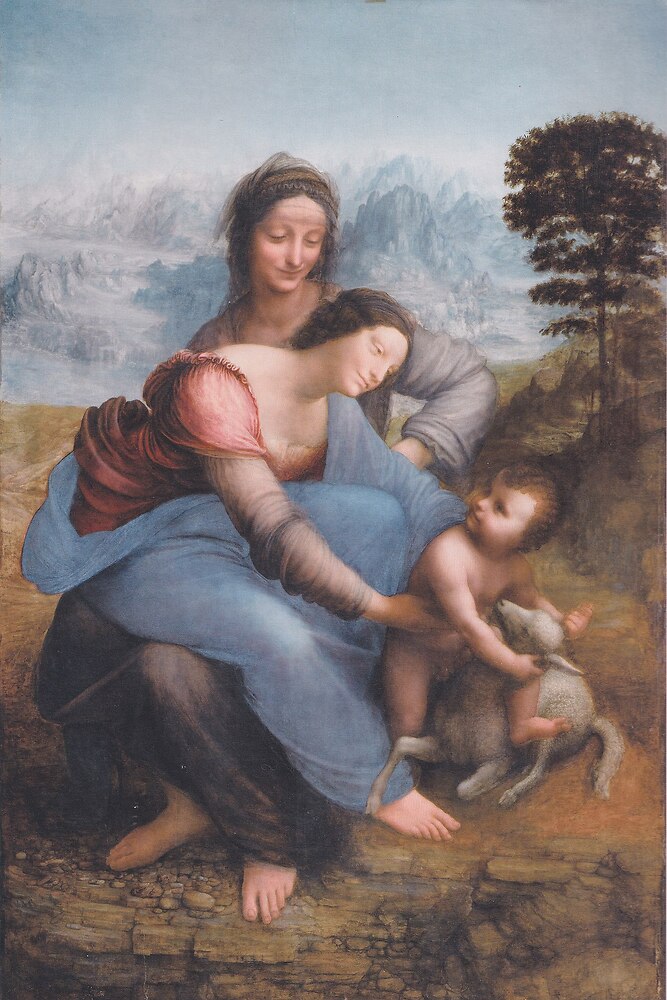
Saint Anne, Mary and Jesus as a child, 1503-1519, Paris, Louvre
by
Leonardo da Vinci
A Western student of Chinese, maintaining a little trove, appreciates it in yet another manner:
Woman 女 and child 子: what a man is fond of
Yet, eastern authors such as ShaoLan Hsueh (薛曉嵐), creator of Chineasy, understand it as the traditional preference for a woman (女) to give birth to a boy (子) rather than a girl (妞).
A phenomenon perhaps perversely enforced in modern times by the one child policy.
There are quite a few Chinese characters presenting reciprocality in their meaning, e.g.:
- 中 [zhòng]: to hit, to be hit by, etc.
- 叫 [jiào]: to call, to be called, etc.
From there, we could reverse the first interpretation we gave (woman’s (女) care for her child (子)) and see it also as the love of a child (子) for his or her mother (女).

Yuanyang hani rice terrace panorama qingkou, Yunnan, China, 2012
by
Chensiyuan
We can push things a little further: the notion of “good” can vary from person to person, from period to period, from culture to culture.
That notion is at least partially constructed. If we admit so, then it is likely that we admit that this notion is built to great degree in childhood, from the mother’s (女) behavior towards her child (子).
An idea that can also be found in the Sānzì Jīng (三字經), traditionally used as written language introduction material for young boys:
That we could translate as:
Men at their birth
Are naturally good.Their natures are much the same;
Their habits become widely different.
Note: This is a great example of the inherent difficulty to translate Chinese, here due to the multiplicity of Chinese definitions for a single character (e.g. 習).
The whole book is available at zhongmu with English translation (Giles’).
And again we can use reciprocality to twist things around: admitting the notion of “good” can be relative, the typical behavior of a child (子) can be said to constitute some sort of absolute “good”.
Hence, while the mother teaches a relative notion of “good” to her child, that same child (子) teaches his or her mother (女) a more absolute notion of “good”.
Not only supported by the previous quote from the Sānzì Jīng (三字經), the idea is also comforted by the common use of “子” as a respectful suffix: Confucius (孔夫子) (whose name was often abbreviated to “子” in literature), Laozi (老子), Mencius (孟子), Xunzi (荀子), Jūn zǐ (君子), Tiān zǐ (天子):
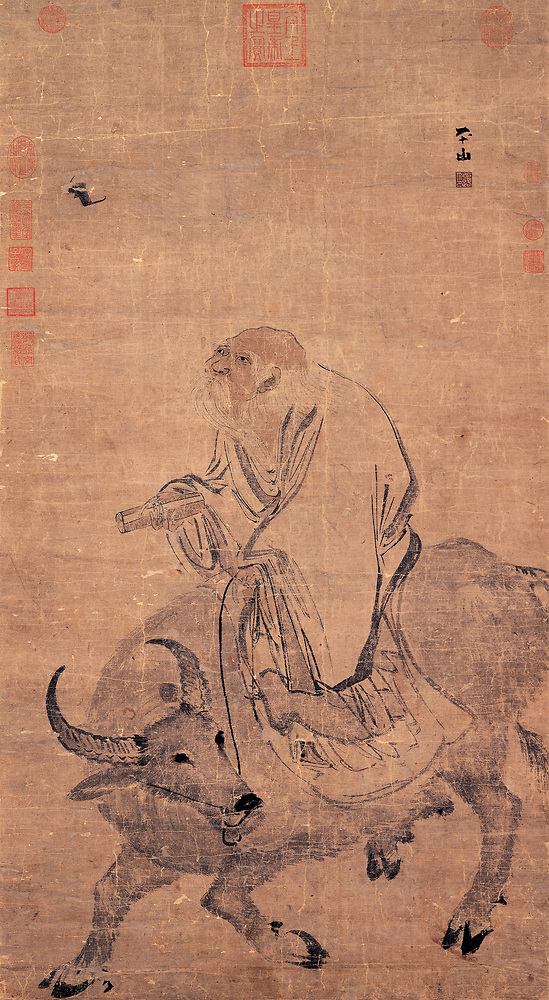
Laozi Riding an Ox (畫老子騎牛) by Zhang Lu (1464–1538) 張路 through wikimedia.org – Public domain
As a side quest, the reader may want to try to develop a composition explanation for the previous painting, given Laozi’s Chinese name,
You may find an answer here.
Confucius, 孔夫子, (551–479 BCE) is a key figure in Chinese culture.
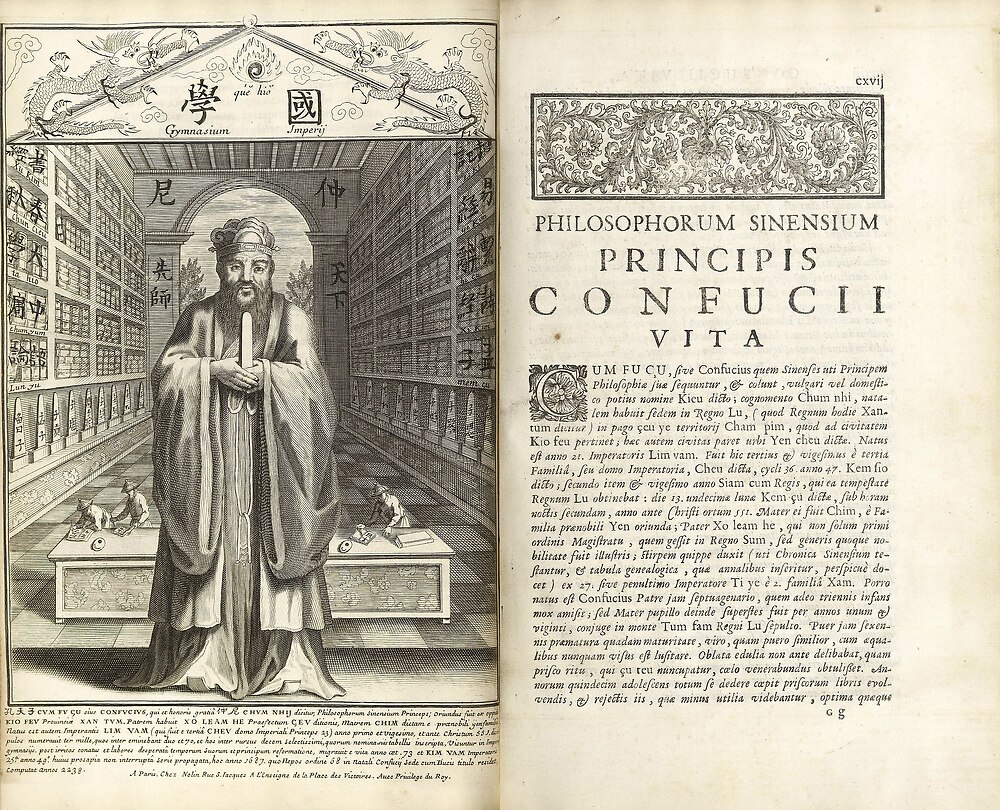
Confucius portrait from the Confucius Sinarum Philosophus
by
Prospero Intorcetta, Philippe Couplet, et al.
He emphasized, among others, the importance of filial piety (孝), that is, the importance of respecting one’s elders.
好 could thus be interpreted as a specific manifestation of filial piety.
Chinese/middle/to hit: 中 [zhōng]
One character, three main meanings:
The “middle” meaning comes naturally from the character’s form: a line centrally crossing a rectangle.
Closely enough, the “hit/to be hit by” meaning arises from typically a projectile hitting the center of a target.
In ancient time, Chinese people used to called themselves the middle kingdom, hence the “China/Chinese” meaning.
As a side note, current “China”’s name, 中國 [Zhōng guó] (“Middle Empire”), first appeared in treatises between England and Emperor Xianfeng (咸豐) following the opium wars.
Coming back to Confucius.
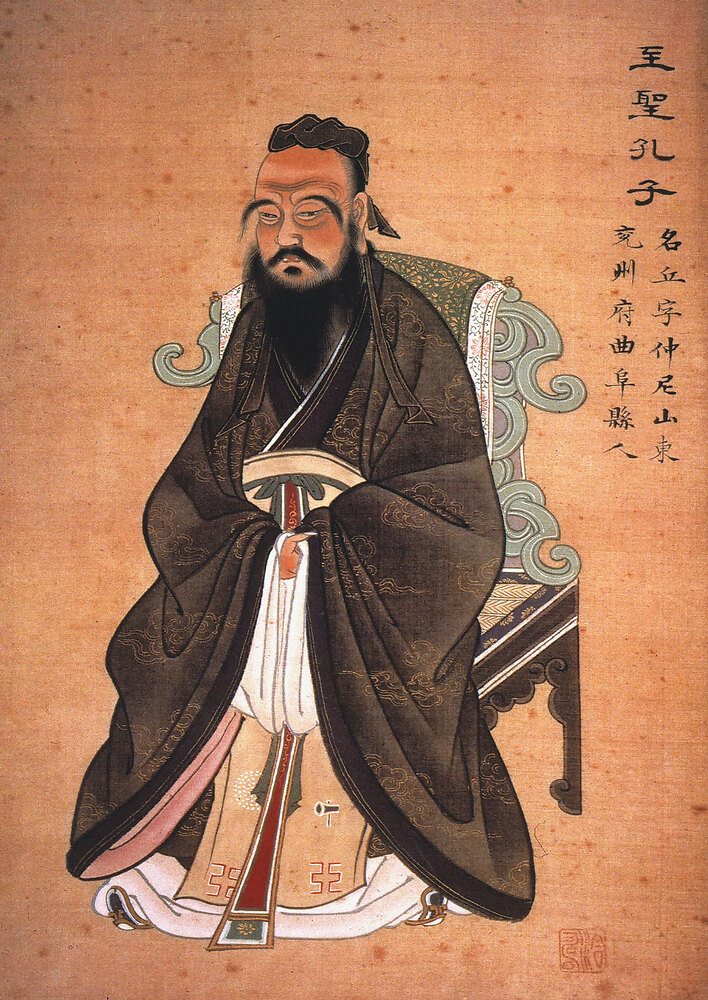
Confucius portrait through granger.com wikimedia.org – Public domain
In addition of the aforementioned filial piety, the thinker was also famous for having taught the doctrine of the mean, 中庸 [zhōng yōng].
Religion: 教 [jiào]
“Religion”, 教, is essentially built around 孝, filial piety.
Hence, given what we just saw about Confucius, “religion” is the culture (攵) of filial piety (孝).
By breaking 孝 into its components, “religion” is also the culture (攵) that is transmitted from elders (耂) to youngsters (子).
Or, closely enough, what the elders (耂) transmit with a hand and a stick (of which 攵 was originally a pictograph) to youngsters (子):
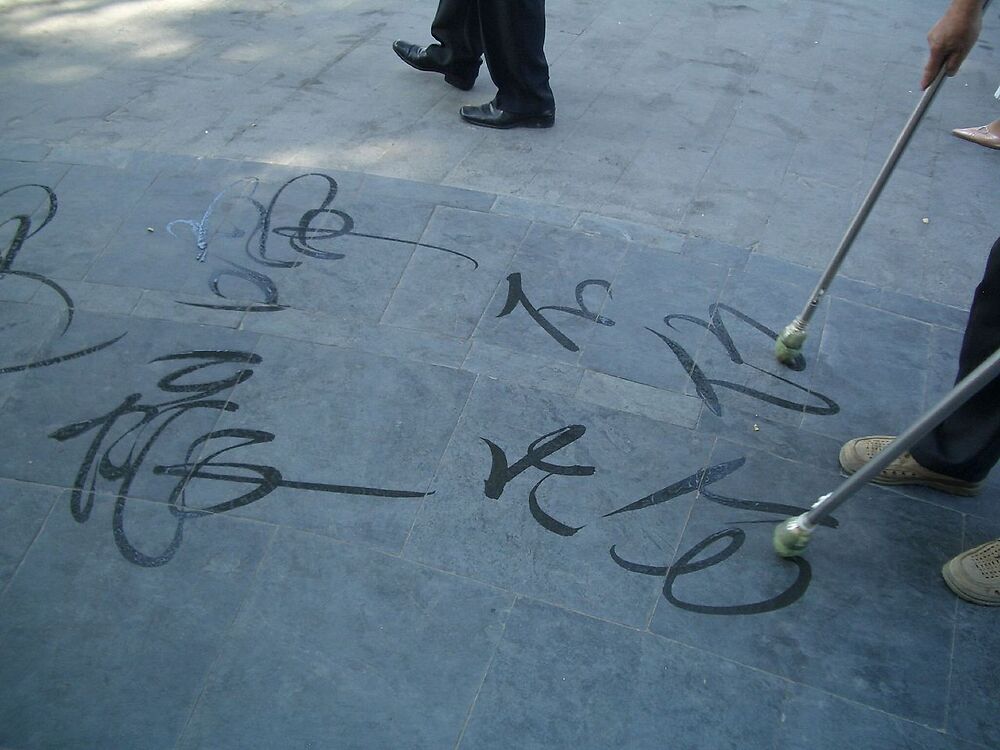
A man writing Chinese calligraphy with water brush at the Summer Palace in Beijing
by
Marc Smith
That last interpretation actually is more obvious given 教’s ancient forms.
To interact 爻 with a child 子 using a rod 攴: to teach – chinese-characters.org.
Note: That idea of sharing information between generations, that is, over time, has recently been identified, explored and named time-binding by Alfred Korzybski (1879 – 1950) in his General Semantics.
To study: 學 [xúe]
Left as an exercise to the reader, whom is invited to look into the external links for some starting points:
Resources
I can only recommend the following websites for proposing treasurable information regarding characters’ definitions, decompositions, interpretations and more:
- chinese-characters.org (en)
- zhongwen.com (en)
- mdbg.net (en) (main source for the definitions used here)
- zdic.net (cn, en, de, fr)
- ctext.org (cn, en)
- www.chinese-poems.com (cn, en)
- resources.allsetlearning.com (en): plenty of free resources on grammar, pronunciation (with .mp3), etc.
- ShaoLan Hsueh (薛曉嵐) @TED.
The followings, collectively called the San Bai Qian (三百千), served for centuries as young Chinese boys’ written language universal introductory material:
- Sānzì Jīng (三字經): Three Character Classic;
- Bǎijiā Xìng (百家姓): Hundred Family Surnames;
- Qiānzì Wén (千字文): Thousand Character Classic.
Shen Yun, a renowned traditional Chinese dance company based in the USA, proposes articles on written Chinese, perfectly suitable as an introduction.

Panorama of Cuiping village, Yangshuo, Guangxi, China 2016
by
Chensiyuan
Comments
By email, at mathieu.bivert chez: